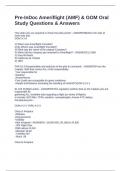Pre-InDoc Ameriflight (AMF) & GOM Oral
Study Questions & Answers
How often are you required to check the pilot portal? - ANSWERSBefore the start of
each duty day.
GOM 3-1-9
1) When was Ameriflight Founded?
2) By Whom was Ameriflight Founded?
3) What was the name of the original Company?
4) When did the company get renamed to Ameriflight? - ANSWERS1) 1968
2) Gary Richards
3) California Air Charter
4) 1987
FAR 91.3 Responsibility and authority of the pilot in command. - ANSWERSYour the
Captain, With that comes ALL of the responsibility.
Your responsible for
-Weather
-Airworthiness
-Fuel Loads are acceptable for given conditions
-Weight and Balance (including the handling of HAZMAT)GOM 12-5-1
91.103 Preflight action - ANSWERSThis regulation outlines that as the Captain you are
responsible for
gathering ALL available data regarding a flight (or series of flights)
to include: NOTAMs, TFRs, weather, runwaylengths, known ATC delays,
fuel planning etc...
GOM 4-2-1 THRU 4-2-3
Class A Airspace
-Altitudes
-Requirements
-Visibility
-Max Airspeed - ANSWERS- 18,000 MSL (FL180) to FL600
- IFR Flight Plan
DME above FL240
Altimeter 29.92
- Visibility N/A
- Mach .99
Class B Airspace
,-Altitudes
-Requirements
-Visibility
-Max Airspeed - ANSWERS- Surface to 7,000 MSL or 12,500 MSL (Depending on the
Airport)
- VFR 3 miles Clear of Clouds 1000 ft. ceilings
- IFR operation VOR receiver
- Mode C veil 30nm requires a Mode C Transponder
-Two way Communication established before entering airspace
-Clearance must be received before entering Class B airspace.
- 250 kts. below 10,000 MSL 200 kts. below Class B Airspace.
Class C Airspace
-Altitudes
-Requirements
-Visibility
-Max Airspeed - ANSWERS- Surface to 4,000 ft. AGL
5nm core surface to 4,000ft AGL
10nm shelf 1,200 ft. AGL to 4,000 ft. AGL
- Operating Control Tower with Radar
- Two way Communication established
- 3sm 1,000 above, 500 below, 2,000 horizontal
- 200 kts.
Class D
-Altitudes
-Requirements
-Visibility
-Max Airspeed - ANSWERS-Surface to 2500 ft. AGL
4 nm radius
- 3sm 1,000 above, 500 below, 2,000 horizontal
-Two way Communication established
- 200 kts
Class E
-Altitudes
-Requirements
-Visibility
-Max Airspeed - ANSWERS-Controlled Airspace Surface to 18,000 ft. generally
-Class E airports have approved weather
-*less than 10,000 ft. MSL *
3sm 1,000 above, 500 below, 2,000 horizontal
-*Greater than 10,000 ft MSL*
5sm 1,000 above, 1,000 below, 1 mile horizontal
300 kts. recommended
, Class G
-Altitudes
-Requirements
-Visibility
-Max Airspeed - ANSWERS-Uncontrolled (Rare in the lower 48 these days)
Surface to 14,500 Airspace
-*Surface to 700 or 1200 AGL Class G airports*
-Daytime 1 mile and Clear of Clouds
-Night 3sm 1,000 above, 500 below, 2,000 horizontal
-*Above 10,000ft MSL* 5sm 1,000 above, 1,000 below, 1 mile horizontal
FAR 91.175 Takeoff & landing under IFR
DA/DH or MDA is dictated by__________________ - ANSWERSThe Approach being
used
-The highest of the DA/DH or the MDA
GOM 4-3-11 & 4-3-12
GOM 5-1-6 & 5-1-7
-High Minimums Captain OpSpec C054 GOM 3-2-6
a. Add 100ft to computed ceiling
b. Add ½ to Visibility
FAR 91.175 Takeoff and landing
under IFR
1) When can you go below DA/DH or MDA? - ANSWERS1) The aircraft is continuously
in a position from which a descent to a landing on the intended runway can be made at
a normal rate of descent using normal maneuvers.
GOM 4-3-11 & 4-3-12
GOM 5-1-6 & 5-1-7
FAR 91.175 Takeoff and landing under IFR
1)Which is Controlling Reported ceilings or RVR?
2)If *before* the FAF and flight visibility is *less* than the visibility prescribed in the
standard instrument approach being used can you continual the approach?
3) If *after* the FAF and flight visibility is *less* than the visibility prescribed in the
standard instrument approach being used can you continual the approach?
4) If visibility goes below minimums, but you have the required visual cue can you
continual? - ANSWERS1) RVR
2) No
3) Yes
4)Yes Unless RVR is reporting less than minimums, then you must go around.
RVR IS ALWAYS CONTROLING




